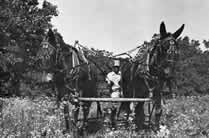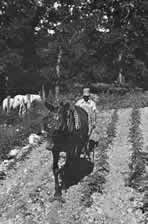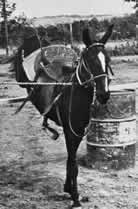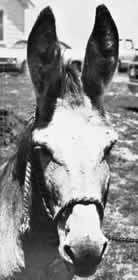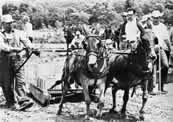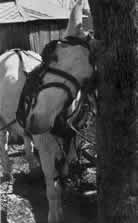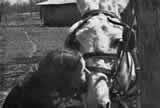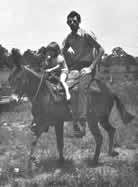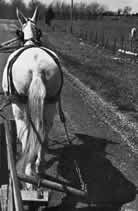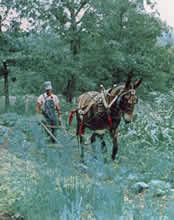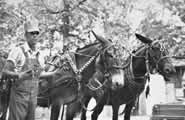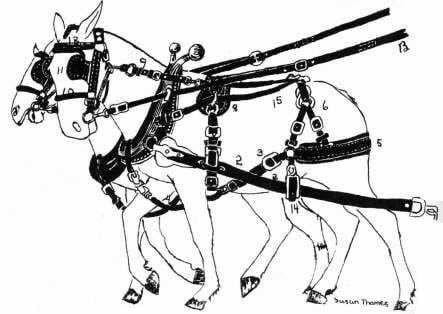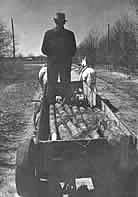(BITTERSWEET, Volume III, No. 1, Fall 1975)
Researched by Mike Doolin, Larry Doyle, Vicki Bench and Terry Tyre
Photos by RobertMcKenzie, Stephen Ludwig, and Larry Doyle
"They've made lots of machinery that replaced horses and mules and lots of it's good. The majority of it is. But they've made nothing yet that would come up with a mule and a double shovel in a potato patch. They never made nothing yet and they never will."
Charley Brittain owns a tractor. But he rarely starts it on his farm. He prefers the two mule power of his team to his many horse powered tractor, using his mule team for everything on his farm from plowing his garden and putting out his corn to mowing his hay. "I don't have a baler or rake, or we'd use them for that too. I like to drive mules and if you like to and don't, you're a fool. That's all there is to it."
Mules are beasts of burden, used only for working and occasionally riding. For almost anything else, they are of little use. Therefore, when mechanized power took over, mules rapidly declined in numbers until now, even in Missouri which is noted for its mules, one has to search for people like Charley who still prefer them for work. unlike the horse, which has increased in number because of its recreational value, the mule population has dwindled to a very few.
Though almost gone now, mules have a long history of use. They orginated in Asia Minor and were sent to Greece at least 3000 years ago. However, they were not used in great numbers in the United States until after the civil War. Then, "Mules were the foundation of the world," Charley asserts. Farmers used them. Miners used them. The army used them. Construction companies used them. They laid the pipe lines, built the railroads, build the power lines, even built the roads.
Since mules, both male and female, are sterile, they will not reproduce. They are a hybrid animal produced by crossing the horse and the ass. A mule is out of a mare (female horse) and a jack (male ass). If a jenny (female ass) is mated with a stallion (male horse), the offspring is called a hinny. Only an expert could distinguish a hinny from a mule because the only major difference is hinnies are slightly narrower at the heel. However, when the two are worked, it is easier to tell the difference for the mule is far less stubborn and works better, so is the cross used most often.
Mules retain characteristics of both parents. From the jack the mule gets its braying voice, sure-footedness, endurance, long ears, thin limbs and small feet. From the mare he gets his large well-shaped body, strong muscles, height and shape of neck and croup. The size of the mule depends on the size of the mare used. Belgian and Percheron mares, or any big draft mare, raise the best mules because their colts are big--around 16 to 16% hands (64 to 66 inches at the withers)--with big bones, big heads, big ears, and calm natures. A draft mare which weighs about 1200 to 1300 pounds will raise mule colts that will weigh about 900 pounds. Saddle mares will raise mule colts that will be smaller--about 15 hands (60 inches) or less--with thin bones, small feet and more nervous natures. A good saddle mare is a more nervous, higher spirited animal than a work horse.
"They've made nothing yet that would come up with a mule and a double shovel in a potato patch." -- Charley Brittain
Today some people use mules for coon hunting because of their surefootedness and their ability to jump. Here a coon hunting mule jumps a fence at a mule show. They are not ridden over the fence, but up to it. The rider dismounts and crosses. Then, holding the reins, he encourages the mule to jump flatfooted over the fence. Some mules can jump over six feet without a running start.
George Washington is credited with beginning the raising of jacks in the United States when Lafayette gave him a jack and two jennies as a gift.
[We'd like to thank the following for help on this story: Charley Brittain, H.W. Davis, Fuget Garrison, C.H. "Dutch" Snyder, Brenda Amos, Richie, Terry and Troy Richardson.]
Mules have at times been extremely valuable and were stolen for profit. One thief's profit was small, however. During the Spanish American War he stole a team of mules from Dave Wilson. The sheriff followed him to the east coast and back to Lebanon, Mo., where he then killed the thief.
Mules, once almost gone, are coming back. Today, they are mostly a hobby. Here a team of small mules pulls over thousand pounds at a mule pulling contest at Stoutland, Missouri.
Some mules fox trot and some mules will do a running walk, but all mules are easy ridding. But after they are ridden a few miles and begin to get tired, they quit on you.
Mules are infamous for their kicking ability. C.H. "Dutch" Snyder once knew an old man who had a 30 year old mule to die. He was using an another horse to drag him off. He dragged him through the gate and the dead mule's leg flew back, hit the old man and broke his leg. That man made the remark that a mule will live and die to get to break your leg.
A mule colt out of a saddle mare will inherit her nature and will not settle down to work like a mule from a draft mare will. As a general rule, the bigger the mule, the easier he is to handle and the better he is to work.
Many people today are using Shetland ponies to raise miniature mules about the size of a Shetland pony. Most people who raise miniature mules do it as a hobby. They use them in mule pulls, or to pull wagons in parades or in show competition, but some, like Warren Shultz, use them to plow gardens for both himself and his neighbors.
Even though mules will not reproduce, they were used far more often than horses in the South. Their life span of 30-35 years is 10-15 more years than a horse's. They are more intelligent, more sure-footed, and tougher. Charley thinks mules are the smartest animal there is. "A mule's not going to hurt himself. If they get hurt, somebody else was the cause of it. They never done it themselves. If a mule gets tangled up in his harness, he won't fight himself to death like some horses will. Before he'll do that, he'll lay down and sull and say, 'I'll be here when you come back.'"
A mule team, like a team of horses, will run away, but usually it is out of orneriness. When they do run away, they won't hurt themselves. When horses run away, they run from fright and for dear life. Sometimes they won't quit until they tear all the harnesses off and will keep on running even into a fence or something solid, often hurting themselves. A mule won't. He will stop first. Waldo Davis once had a team of mules hitched with a saddle mare who ran away. "They run for over a mile, hung up down there in the river bottom in the fence. One mule out run the others and circled them around and run them into the fence, hung them up. Well, we was quite a little while getting down there. Them mules was a-standing still as they could and this mare was a-kicking and pulling and trying to get loose. The mules was just standing there still as a cat stood. Now that's just the difference between a mule and a horse."
Mules can stand heat better than horses. Their ability to do a third more work on a third less feed on a hot day made them popular in the South. On a hot day, a horse can be worked to death. When a horse gets hot, he starts to fret. The more he frets, the hotter he gets. Eventually, if worked long enough, the heat will kill a horse. But a mule, when he gets hot, starts coasting, getting lazier to save himself back. When he comes to the end of a row, he will take enough time turning around to head back, so by the time he is turned around, he has his wind back and can work longer.
Mules have smaller feet than horses, so are better for working in gardens because they won't trample the plants down. They will not stumble and unlike a horse who will wind, will pull straight. They resist disease better than horses and they will not eat too much and founder. Also, they will not fight among themselves like horses will.
A pulling horse will out pull a mule, though, because a horse will use all the strength he has. A mule won't. He will use just what it takes to pull a load and not a pound more. If the load is too heavy, he will not try too hard to move it. The horse will keep on trying even if the load is impossibly heavy.
Mules do everything the easy way, including learning. Thus, they are easier to break than horses. They may put up more fight at first, but they give up quicker. Once something is learned, mules never forget it.
The first step in breaking a mule is to know at least a little more than the mule. They are started as two year olds before they get too strong. Most people start by teaming the young mule with a broken mule or horse first. Waldo Davis who has broken over 300 mules and handled over 2000 says to break a mule, "You just catch them and tie them up and put the harness on them. Hook them by one that's broken and push it around to your plow. Get it still enough to get it hooked and get behind it and start out a-working till you wear it down. The broke one has to kind of handle it, though. When you say, 'Whoa,' the broke stock will tell the other one he has to stop. You just work them till you wear them down. Some of them last all day and some of them don't last over a half a day. You work them till they are pretty tired, till you can't get them to go as a rule. Just as a rule when they get about two-thirds of the way tired, they'll stop. When ever they get tired that-a-way, pull the lines to work them bits. You can say 'Whoa' and get them stopped.
Then say 'Get up' and whip them a little or your old one will start. Say 'Get up' and they will go just a little ways, and then say 'Whoa' and the old one will stop. They'll learn that in twenty minutes time, a lot of them. In three or four days you can handle it in field work, but you couldn't on the road."
The last mules Waldo broke, he used a harness he called a "W." The "W" teaches young mules what "Whoa" means about the third time he hears it, usually in about five minutes. To hook up a "W" harness the young mule. Put a leather strap around each front ankle with a steel ring fastened to the strap on the inside of each foot. Run the rope on down the inside of the front leg, through the ring on the ankle, back up to a ring where the pole strap joins the collar, down to the ring on the other ankle and back up to the ring on the hames on the other side. The two ends of the rope go back to the driver and are held like lines.
Once the mule starts moving (getting the mule moving may be a small problem) say "Whoa" and pull on the rope. The rope causes the mule to fall to his knees. Waldo says, "It may jump up a little bit to start off. When you pull that again and say 'Whoa,' about the third time when he hears you, he'll know what 'Whoa' is. That really works. First time I tried it I had a pair of sorrel mules here. They was big mules. We worked about two hours getting them around. One of them here, she'd fight and bite. And we even put them "W's" on them mules before we harnessed them. We turned that one mule loose down there in the drive way and she started out there and I hollered 'Whoa' and she was going with such a force that she went right over on her back. She just turned a flip flop. I ran around in behind her and she got up and started again. I hollered 'Whoa' and I think I throwed her about nine or ten times. After a while we harnessed her and didn't even tie her up. She knew what 'Whoa' was. She'd start to move--just flinch. Now she had her feet on the ground, you see. She was afraid a little bit to move. We put the pair of them on a wagon out there in a horse lot, and we started up this country road up here, crossed a low water bridge and down onto the highway, drove them up to my brother's. When we got back home, those mules was broke. I picked corn with them the next day. That's just how quick they're broke."
"I was offered a thousand dollars for them and I sure won't take it for them. If I had, I would have done sold them. Like I told him we was both fools. He was a fool for offering and I was a fool for not selling, but I didn't want to sell them and I still don't want to sell them. You could buy them just as quick for a dollar as for a thousand. I've seen the day when they would of sold for forty." --Charley Brittain
Parts of the Harness
1. hames
2. tugs
3. jack strap
4. pole strap
5. breeching
6. hip strap
7. back band strap
8. back band
9. gag reins
10. nose piece
11. blind bridle
12. brow band
13. lines
14. lug strap
15. side straps
Mules are a one man animal and prefer the person who works them to anyone else. If they are sold, or a new person starts working them, they will get used to the new person if given enough time. But, at first they get homesick, and, if given an opportunity, will come home. Charley Brittain once sold a pair of mules who got homesick.
"I sold a guy a pair of mules down in Arkansas. I had the mules five years and broke them and he bought them. He come up here on Saturday and got them. He hauled them all the way to Jonesboro, Arkansas in a horse trailer and they can't see out, only just what little they can see in front. Anyway, he called me on Tuesday and said, 'The mules ain't eat a bite nor drunk a drop of water since they'd been here. What am I going to do with them?' I said, 'You better leave them in the barn. They'll leave if you ever turn them out. They're homesick. That's what's the matter with them. They're homesick.' He said, 'If they don't eat by tomorrow, I'm going to turn them out.' I said, 'I bet you $5 they'll leave if you do.' They never had gone through a fence. 1 mean they wouldn't go through a fence. Anyway, he turned them out Wednesday night and when he got up Thursday morning, they was gone. They just pawed his gate down and left. You know where we found them? Over the other side of Fort Leonard Wood. They made it to right there. And I went over and caught them. He couldn't even catch them. He found them on Monday right there. And they had come all that way from down there on their own back to there (about 200 miles). They got the instinct to know where home is. If he'd left them alone, they'd made her in that day, too."
When we first started researching this story, we were told that mules were almost gone. Nobody used them anymore. But, as long as there are people like Charley Brittain around, there'll always be mules.
"A mule'll learn more in the barn than a horse will out working because he'll stand around and figure it out. I like them better'n horses. I'd rather work them. Yes, I'll tell you, if there's anyone who likes mules better'n me, I don't know how he stands it."
Fuget Garrison's mules take him home after an afternoon of fixing fences.
